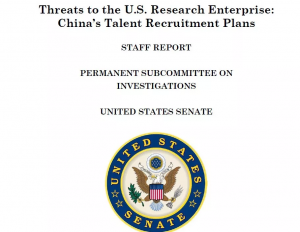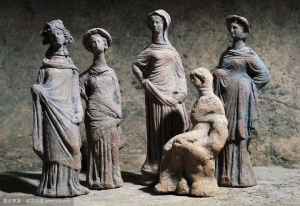United States Senate PERMANENT SUBCOMMITTEE ON INVESTIGATIONS Committee on Homeland Security and Governmental Affairs
Rob Portman, Chairman Tom Carper, Ranking Member

I. EXECUTIVE SUMMARY
American taxpayers contribute over $150 billion each year to scientific research in the United States. Through entities like the National Science Foundation, the National Institutes of Health and the Department of Energy’s National Labs, taxpayers fund innovations that contribute to our national security and profoundly change the way we live. America built this successful research enterprise on certain values: reciprocity, integrity, merit-based competition, and transparency. These values foster a free exchange of ideas, encourage the most rigorous research results to flourish, and ensure that researchers receive the benefit of their intellectual capital. The open nature of research in America is manifest; we encourage our researchers and scientists to “stand on the shoulders of giants.” In turn, America attracts the best and brightest. Foreign researchers and scholars travel to the United States just to participate in the advancement of science and technology.
Some countries, however, seek to exploit America’s openness to advance their own national interests. The most aggressive of them has been China. China primarily does this through its more than 200 talent recruitment plans—the most prominent of which is the Thousand Talents Plan. Launched in 2008, the Thousand Talents Plan incentivizes individuals engaged in research and development in the United States to transmit the knowledge and research they gain here to China in exchange for salaries, research funding, lab space, and other incentives. China unfairly uses the American research and expertise it obtains for its own economic and military gain. In recent years, federal agencies have discovered talent recruitment plan members who downloaded sensitive electronic research files before leaving to return to China, submitted false information when applying for grant funds, and willfully failed to disclose receiving money from the Chinese government on U.S. grant applications.
This report exposes how American taxpayer funded research has contributed to China’s global rise over the last 20 years. During that time, China openly recruited U.S.-based researchers, scientists, and experts in the public and private sector to provide China with knowledge and intellectual capital in exchange for monetary gain and other benefits. At the same time, the federal government’s
grant-making agencies did little to prevent this from happening, nor did the FBI and other federal agencies develop a coordinated response to mitigate the threat. These failures continue to undermine the integrity of the American research enterprise and endanger our national security.
* * * *
China aims to be the world’s leader in science and technology (“S&T”) by 2050. To achieve its S&T goals, China has implemented a whole-of-government campaign to recruit talent and foreign experts from around the world. China’s campaign is well financed. According to an analysis by the FBI, China has pledged to spend 15 percent of its gross domestic product on improving human resources from 2008 to 2020. That amounts to an investment of more than $2 trillion. For the Chinese government, international scientific collaboration is not about advancing science, it is to advance China’s national security interests.
China’s Talent Recruitment Plans. Foreign trained scientists and experts provide China access to know-how, expertise, and foreign technology—all necessary for China’s economic development and military modernization. While China has created and manages more than 200 talent recruitment plans, this report focuses on the Thousand Talents Plan. China designed the Thousand Talents Plan to recruit 2,000 high-quality overseas talents, including scientists, engineers, entrepreneurs, and finance experts. The plan provides salaries, research funding, lab space, and other incentives to lure experts into researching for China. According to one report,
by 2017, China dramatically exceeded its recruitment goal, having recruited more than 7,000 “high-end professionals,” including several Nobel laureates.
The Chinese Communist Party (the “Party”) plays a lead role in
administering the Thousand Talents Plan. The Party recognized the need to control overseas talent recruitment efforts to ensure the program served its priorities. The Party created a “complex system of administration and oversight to coordinate its
recruitment efforts.” The Party is able to “exert exceptional” levels of control over the Thousand Talents Plan and other talent recruitment plans. To ensure control, Thousand Talents Plan members sign legally binding contracts.
Contracting with the Chinese Government. Thousand Talent Plan members sign legally binding contracts with Chinese institutions, like universities and research institutions. The contracts can incentivize members to lie on grant applications to U.S. grant-making agencies, set up “shadow labs” in China working
on research identical to their U.S. research, and, in some cases, transfer U.S. scientists’ hard-earned intellectual capital. Some of the contracts also contain nondisclosure provisions and require the Chinese government’s permission to terminate the agreement, giving the Chinese government significant leverage over
talent recruitment plan members. These provisions are in stark contrast to the U.S. research community’s basic norms, values, and principles. Annexed to this report are Chinese talent recruitment plan contracts that illustrate exactly what talent recruitment plan members agree to when they become members.
Case Examples. This report includes selected examples from U.S. grant making agencies involving Chinese talent recruitment plan members. For example, talent recruitment plan members removed 30,000 electronic files before leaving for China, submitted false information when applying for grant funds, filed a patent
based on U.S. government-funded research, and hired other Chinese talent recruitment plan members to work on U.S. national security topics. One Chinese talent recruitment plan member stole proprietary defense information related to
U.S. military jet engines, and others have contractually agreed to give Chinese institutions intellectual property rights that overlapped with research conducted at U.S. institutions. Annexed to this report are case examples provided by several federal agencies.
Talent Plans Go Underground. Following public testimony and U.S. government scrutiny, the Chinese government started deleting online references to the Thousand Talents Plan in October 2018. For example, China deleted news articles featuring Thousand Talents Plan members, Chinese universities stopped promoting the program on their websites, and the official Thousand Talent Plan site deleted the names of scientists participating in the program. The Chinese
government has also instructed talent recruitment organizations that “the phrase ‘Thousand Talents Plan’ should not appear in written circulars/notices.” Despite this censorship, China’s talent recruitment plans continue.
* * * *
The Subcommittee reviewed seven federal agencies’ efforts to mitigate the threat that Chinese talent recruitment plans pose to the U.S. research enterprise, including U.S.-funded research. While China has a strategic plan to acquire knowledge and intellectual property from researchers, scientists, and the U.S. private sector, the U.S. government does not have a comprehensive strategy to combat this threat.
The National Science Foundation (“NSF”) funds approximately 27
percent of all federally funded basic research at U.S. colleges and universities, leading to 12,000 annual awards to more than 40,000 recipients. In light of Chinese talent recruitment plan members’ misappropriation of NSF funding, NSF has taken several steps—albeit insufficient ones—to mitigate this risk. As of July 2019, NSF policy prohibits federal employees from participating in foreign talent recruitment plans, but the policy does not apply to NSF-funded researchers. These NSF-funded researchers are the individuals mostly likely to be members of foreign talent recruitment plans. The NSF also does not vet grantees before awarding them funding. Instead, NSF relies on sponsoring institutions to vet and conduct due diligence on potential grantees. NSF has no dedicated staff to ensure compliance with NSF grant terms.
The National Institutes of Health (“NIH”) invests over $31 billion annually in medical research through 50,000 competitive grants to more than 300,000 researchers. NIH has recently found instances of talent recruitment plan members committing grant fraud and transferring intellectual capital and property. It also found possible malign foreign influence in its peer review process. NIH has attempted to address these issues, but significant gaps in NIH’s grant integrity process remain. Much like the NSF, NIH relies on institutions to solicit and review disclosures of financial conflicts by its employees participating in NIH-funded research. Unlike the NSF, the NIH has a Division of Grants Compliance and Oversight that conducts site visits at institutions to advance compliance and provide oversight. The number of oversight visits to institutions has fallen from 28 in 2012 to only three last year. NIH officials remain concerned that China’s talent recruitment plans are more pervasive than what they have uncovered to date.
The Department of Energy (“Energy”) is the largest federal sponsor of basic research in the physical sciences. Energy awards $6.6 billion in grants and contracts annually that support over 25,000 researchers at over 300 institutions and National Labs. Energy’s research funding and prominent role in advanced research and development make it particularly attractive to the Chinese government. Energy has recently identified Thousand Talent Plan members working on sensitive research at National Labs and Thousand Talent Plan members with security clearances. Energy has been slow to address vulnerabilities surrounding the openness of its National Labs and its scientific collaboration with the 35,000 foreign nationals who conduct research at the National Labs each year. For example, in December 2018, Energy began requiring all foreign nationals’ curricula vitae be included in Foreign Visits and Assignments requests to Energy facilities as well as in the Foreign Access Central Tracking System database. Despite 30-year old federal regulations prohibiting U.S. government employees from receiving foreign compensation, Energy clarified only this year that employees and contractors are prohibited from participating in foreign talent recruitment plans.
The State Department (“State”) issues nonimmigrant visas (“NIV”) to foreign nationals seeking to visit the United States to study, work, or conduct research. It is on the front line in the U.S. government efforts to protect against intellectual property theft and illicit technology transfers. While State has a process to review NIV applicants attempting to violate export control laws, State’s authority to deny visas is limited. State’s review process leads to less than five percent of reviewed applicants being denied a visa. Nor does State systematically track visa applicants linked to China’s talent recruitment plans, even though some applicants linked to Chinese talent recruitment plans have engaged in intellectual property theft.
The Department of Commerce’s (“Commerce”) Bureau of Industry and Security conducts assessments of defense-related technologies and “administers export controls of dual-use items which have both military and commercial applications.” Commerce is also responsible for issuing deemed export licenses to firms that employ or host foreign nationals seeking to work on controlled technology projects. The Subcommittee found that Commerce rarely denies a application for a deemed export license. Commerce’s denial rate in 2018 for deemed export licenses was only 1.1 percent. Commerce officials told the Subcommittee that it has not revoked a deemed export license in the past five years, despite the recent listing of new entities on Commerce’s Entity List that require additional scrutiny. Commerce issued deemed export licenses to Chinese nationals who participated in talent recruitment plans, had ties to Huawei, and were affiliated with other concerning entities.
The Federal Bureau of Investigation (“FBI”) protects the United States from foreign intelligence operations and espionage. The FBI, however, has recognized that it was “was slow to recognize the threat of the Chinese Talent Plans.” It was not until mid-2018, however, that FBI headquarters in Washington, D.C. took control of the FBI’s response to the threat. Moreover, after collecting information on suspected talent plan participants, the FBI waited nearly two years to coordinate and provide those details to federal grant-making agencies. This delay likely prevented the federal government from identifying talent recruitment plan members who engaged in illegal or unethical grant practices or the unauthorized transfer of technology. The FBI has yet to develop an effective, nationwide strategy to warn universities, government laboratories, and the broader public of the risks of foreign talent recruitment plans.
The White House Office of Science and Technology Policy (“OSTP”) has formal authority to convene all research funding agencies on matters of policy through the National Science and Technology Council. OSTP formally established a joint committee in May 2019 to begin a policy review to coordinate efforts to adopt best practices across the federal government to mitigate foreign exploitation of the U.S. open innovation system. This review is intended to develop a longer-term strategy for balancing engagement and risk without stifling innovation. The U.S. government’s vast and varied array of grant-making agencies complicates this policy review.
* * * *
As American policy makers navigate an increasingly complicated relationship with China, it is not in our national security interest to fund China’s economic and military development with taxpayer dollars. China’s talent recruitment plans, including the Thousand Talents Plan, undermine the integrity of our research enterprise and harm our economic and national security interests.
U.S. universities and U.S.-based researchers must take responsibility in addressing this threat. If U.S. universities can vet employees for scientific rigor or allegations of plagiarism, they also can vet for financial conflicts of interests and foreign sources of funding. If U.S. researchers can assess potential collaborators’ research aptitude and their past publications, they should know their collaborators’ affiliations and their research intentions.
The U.S. academic community is in the crosshairs of not only foreign competitors contending for the best and brightest, but also of foreign nation states that seek to transfer valuable intellectual capital and steal intellectual property. As the academic community looks to the federal government for guidance and direction on mitigating threats, the U.S. government must provide effective, useful, timely, and specific threat information and tools to counter the threats.
Based on this investigation, the Subcommittee finds that the federal government has failed to stop China from acquiring knowledge and intellectual property from U.S. taxpayer funded researchers and scientists. Nor do federal agencies have a comprehensive strategy to combat this threat.
The Subcommittee’s Investigations
This investigation continues the Subcommittee’s examination of national security issues involving China. During the 115th Congress, the Subcommittee highlighted China’s leading role in the opioid crisis by investigating how illicit opioids like fentanyl are shipped from China to the United States through international mail. The Subcommittee held an initial oversight hearing on May 25,
2017, titled Stopping the Shipment of Synthetic Opioids: Oversight of U.S. Strategy to Combat Illicit Drugs. On January 25, 2018, the Subcommittee held a second hearing and issued a bipartisan report titled Combatting the Opioid Crisis: Exploiting Vulnerabilities in International Mail. On October 24, 2018, the President signed into law the Synthetic Trafficking & Overdose Prevention Act (“STOP Act”), legislation designed to assist law enforcement in identifying and stopping fentanyl being shipped into the United States.
In the current 116th Congress, on February 28, 2019, the Subcommittee held a hearing and issued a bipartisan report titled China’s Impact on the U.S. Education System. The Subcommittee examined China’s propaganda efforts at U.S. colleges and universities through Confucius Institutes. The Chinese government funds Confucius Institutes and hires Chinese teachers to teach language and culture classes to students and non-student community members. Confucius Institute funding comes with strings that can compromise academic freedom. The Chinese government approves all teachers, events, and speakers. Some U.S. schools contractually agree that both Chinese and U.S. laws will apply. The Chinese teachers sign contracts with the Chinese government pledging they will not damage Chinese national interests. The Subcommittee found that these limitations export China’s censorship of political debate to the United States and prevent the academic community from discussing topics that the Chinese government believes are politically sensitive.
Next, the Subcommittee turned to China’s talent recruitment plans. The Subcommittee focused specifically on China’s most prominent plan, the Thousand Talents Plan. The Subcommittee reviewed documents, received briefings, or interviewed individuals from the following agencies: Office of Director of National Intelligence; Central Intelligence Agency; Department of State; Department of Commerce; Department of Energy; Federal Bureau of Investigation; Department of Health and Human Services; National Science Foundation; and the White House Office of Science and Technology Policy. The Subcommittee also met with members of the academic community, including the American Public and Land Grant Universities, Association of American Universities, the American Council on Education, a Chinese American advocacy group, and the JASON independent scientific advisory group.
II. FINDINGS OF FACT AND RECOMMENDATIONS
Findings of Fact
1) China seeks to become a science and technology (“S&T”) world
leader by 2050. The Chinese government elevated the importance of S&T as a key national strategic goal in 2006. China seeks to become an “innovative country” by 2020 and an S&T world leader by 2050. To accomplish its goals, China systematically targets critical technologies and advanced S&T capabilities as a way to enhance national strength and achieve Chairman Xi Jinping’s goal of “national rejuvenation.”
2) China prioritizes military-civilian fusion as a national goal. In 2016, Chairman Xi designated a policy known as Military-Civilian Fusion (“MCF”) as a national strategy. MCF seeks to pool talent and financial resources to jointly develop technologies, conduct research, and attract talent that mutually reinforces both the military and civilian sectors. MCF blurs the
lines between China’s defense and civilian sectors, enabling China to
continue international scientific collaboration while obfuscating that this collaboration also assists in modernizing China’s military.
3) China aggressively recruits overseas researchers and scientists.
China has a coordinated global campaign to recruit overseas S&T experts as part of its S&T strategy. These experts provide access to know-how, expertise, and foreign technology—all necessary for China’s economic development and military modernization. Chinese recruitment efforts also
have begun to reverse China’s brain drain, as more Chinese students than before are returning to China after studying abroad.
4) The Thousand Talents Plan (“TTP”) is China’s most prominent talent recruitment plan. Launched in 2008 and controlled by the Chinese Communist Party, the TTP recruits thousands of high-quality overseas talents. As of 2017, China reportedly has recruited 7,000 researchers and scientists. The TTP targets U.S.-based researchers and scientists, regardless of ethnicity or citizenship, who focus on or have access to cutting-edge research and technology. The TTP is just one of over 200 Chinese talent
recruitment plans over which the Chinese Communist Party is able to “exert exceptional” levels of control. In response to U.S. government scrutiny, China has attempted to delete online references to its talent recruitment plans and reportedly instructed Chinese institutions on how to avoid additional U.S. scrutiny.
5) TTP employment contracts violate U.S. research values. TTP
members sign legally binding contracts with Chinese institutions that contain provisions that violate U.S. research values, including non-disclosure provisions related to their research and employment with Chinese institutions. The contracts require TTP members to undermine fundamental U.S. scientific norms of transparency, reciprocity, merit-based competition, and integrity. Fundamentally, these contracts incentivize TTP members to put China’s interests ahead of U.S. institutions.
6) Chinese talent plans target unrestricted, basic research. China seeks access to non-public fundamental research to accelerate its technological capabilities at the U.S. taxpayer’s expense. The U.S. government may restrict some research for proprietary or national security reasons but as fundamental research is generally designed to be openly shared, federal law enforcement agencies have limited means to thwart China’s extralegal activities.
7) TTP members have willfully failed to disclose their TTP
membership. Some TTP members willfully failed to disclose their affiliation with China’s talent recruitment plans to U.S. institutions and U.S. grantmaking agencies. In some cases, TTP members received both U.S. grants and Chinese grants for similar research, established “shadow labs” in China to conduct parallel research, and stole intellectual capital and property. U.S. government agencies also discovered that some TTP members used their access to research information to provide their Chinese employer with
important information on early stage research.
8) Federal agencies are not prepared to prevent China from
transferring taxpayer funded research and stealing intellectual
property. The U.S. government was slow to address the threat of China’s talent recruitment plans, leading to U.S. government grant dollars and private sector technologies being repurposed to support China’s economic and military goals. Though some federal agencies have begun to take action, the federal government lacks an effective interagency strategy and continues to
have shortfalls in its processes to mitigate the threat that Chinese talent
recruitment plans pose.
9) Federal grant-making agencies lack standards and coordination.
U.S. grant-making agencies, such as the National Science Foundation
(“NSF”) and the National Institutes of Health (“NIH”), each require grant applicants to use different forms and processes to apply for federally funded research grants. This increases administrative burdens on researchers applying for grants from multiple federal agencies. It also complicates effective grant oversight of the more than $150 billion in U.S. funding awarded annually for research and development.
10) U.S. grant-making agencies’ policies on foreign talent recruitment plans differ. For example, the Department of Energy’s new policy effectively bans both employee and contractor participation in foreign talent recruitment plans. The NSF’s new policy, however, only applies to NSF employees, but not researchers. These differences can complicate the research community’s understanding of the scope and scale of the problem.
11) The NSF does not have a compliance office to perform grant
oversight functions. Instead, the NSF relies on the institutions submitting grant applications and the NSF Inspector General to conduct due diligence, vetting, and oversight. The NSF’s policy on participation in foreign talent recruitment plans does not extend to the more than 40,000 researchers and scientists that receive U.S. funding for research and development.
12) The NIH awards over $31 billion annually in medical research in 50,000 competitive grants to more than 300,000 researchers. The NIH has not issued new policies addressing talent recruitment programs. Instead, it relies on existing policies regarding conflict of interest, conflict of commitment, and disclosure of outside support. The NIH is conducting additional oversight of potential links between federal funding and foreign talent recruitment plans. As part of that process, it identified at least 75 individuals potentially linked to foreign talent recruitment plans that also served as peer reviewers.
13) The Department of Energy (“Energy”) is the largest federal sponsor of basic research in the physical sciences, funding $6.6 billion in grants and contracts that support over 25,000 researchers at over 300 institutions and National Labs. Energy’s research funding and prominent role in advanced research and development make it particularly attractive to the Chinese government. Despite 30-year old federal regulations prohibiting
U.S. government employees from receiving foreign compensation that conflicts with their official duties, Energy clarified only this year that employees and contractors are prohibited from participating in foreign talent plans.
14) The Commerce Department (“Commerce”) granted deemed export licenses to Chinese nationals associated with talent recruitment plans, Chinese military affiliated universities, and other entities on Commerce’s entity list. The entity list includes individuals and entities “who have engaged in activities that could result in an increased risk of the diversion of exported, re-exported, and transferred items to weapons of mass destruction programs.” The list also includes “activities contrary to U.S. national security and/or foreign policy interests.” Commerce is responsible for issuing deemed export licenses to U.S. firms that employ or host foreign nationals seeking to work on controlled technology projects. Commerce rarely denies deemed export license applications, denying only 1.3 percent in 2018.
15) The FBI recognized that it and other federal agencies were “slow to recognize the threat of the Chinese talent [recruitment] plans” until recently. Despite the Chinese government publicly announcing in 2008 its intent to recruit overseas researchers with access to advanced research and technology, FBI’s headquarters in Washington D.C. did take control of the response to the threat until mid-2018. The FBI took nearly two years to coordinate the dissemination of information identifying potential talent
recruitment plan participants to federal grant-making agencies. The FBI has yet to develop an effective, nationwide strategy to warn universities, government laboratories, and the broader public of the risks of foreign talent recruitment plans.
16) The State Department is on the frontline in the U.S. government
effort to protect against intellectual property theft and illicit
technology transfers. While State has a process to screen for nonimmigrant visa applicants attempting to steal sensitive technologies or intellectual property, State’s authority to deny visas is limited. This results in a denial rate of less than five percent of all visa applicants reviewed. State also does not make available visa applicant files and supporting documentation to U.S. law enforcement in easily accessible formats to assist
national security investigations.
17) The White House’s OSTP launched an effort in May 2019 to
coordinate interagency work related to improving the safety,
integrity, and productivity of research settings. Currently, federal
grant-making agencies’ policies and processes are not standardized or uniform. These differences complicate the grant process for applicants, stifle U.S. law enforcement’s ability to investigate grant-related crimes, and frustrate the federal government’s ability to comprehensively understand grant spending.
Recommendations
1) Federal agencies must develop a comprehensive strategy to combat both illegal and extralegal transfers of U.S. intellectual capital. China uses illegal and extralegal mechanisms to acquire U.S. intellectual property, research, and sensitive technologies. Federal agencies should work with the U.S. research community to balance the need for international collaboration while securing U.S.-government funded research.
2) Federal agencies should declassify and disseminate more
information on foreign talent recruitment plans. Additional
information from the U.S. intelligence community, federal law enforcement, and federal grant-making agencies will help define the scope and scale of the problem so that U.S. research institutions can effectively mitigate risks associated with foreign talent recruitment plans.
3) While taking steps to better protect research and intellectual property, Congress and the Executive Branch should reaffirm the critical importance of foreign students and researchers in the United States and the importance of international research collaboration. Congress should provide stable and sustained funding for scientific research sponsored by federal agencies and support programs aimed at keeping scientists and their work in the United States.
4) Federal law enforcement agencies and members of the intelligence community must better tailor engagement with the U.S. research community to ensure that threat information is accessible and actionable. The FBI should develop a cohesive strategy to ensure outreach by its headquarters and 56 field offices is effective, consistent, and timely.
5) U.S. grant-making agencies should harmonize the grant proposal process and standardize reporting requirements for disclosing all foreign conflicts of interest, conflicts of commitment, and all outside and foreign support. Standardization and harmonization will reduce the administrative burden on research institutions applying for federal research funding and promote data sharing across the U.S. research enterprise. A government-wide standard should require documents be machine readable to encourage automation to assist with identifying grant fraud.
6) The U.S. research community should establish a “Know Your Collaborator” culture. U.S. research institutions should establish best practices in monitoring scientific and research collaboration with foreign nationals and determining whether such collaboration adheres to U.S. scientific research values, especially in the area of research integrity. U.S. research institutions also should investigate and adjudicate allegations of failures to disclose conflicts of interest, commitment, or other outside support.
7) U.S. grant-making agencies should implement a compliance and
auditing program to ensure grantees accurately report conflicts of
interest and conflicts of commitment. Congress should provide adequate resources to support agency compliance programs and inspectors general.
8) U.S. grant-making agencies conducting or funding U.S. government research should share information regarding grant recipients with access to U.S. government funding and research facilities. This information should be made available as appropriate to foster scientific collaboration and used by funding agencies to assess the qualifications of researchers.
9) The Commerce Department should ensure its interagency process for identifying emerging and foundational technologies that are essential to the national security of the United States includes a review of fundamental research. As appropriate and necessary, the Commerce Department should add foundational technologies and areas of fundamental research to its export control lists.
10) The State Department should identify any additional authorities needed to deny non-immigrant visas for individuals suspected of engaging in illegal or extralegal transfers of technology, intellectual property, and fundamental research. State also should include additional security related questions designed to detect foreign government sponsorship of research conducted in the United States and whether the visa applicant intends to legally or illegally transfer research and technology back to their home country on visa applications. State should automate security reviews of visa applicants for illicit transfers of technology, intellectual property, and fundamental research.
11) The administration should consider updating NSDD-189 and implement additional, limited restrictions on U.S. government funded fundamental research. NSDD-189 was issued in 1985 and established the national policy that products of fundamental research are to remain unrestricted to the maximum extent possible. Federal agencies must not only combat illegal transfers of controlled or classified research, but assess whether openly sharing some types of fundamental research is in the nation’s interest.
12) Federal law enforcement and other relevant agencies should identify U.S.-based entities that serve as recruitment networks, platforms, or foreign government proxies that facilitate or broker in statesponsored talent recruitment. Additional investigations and publications are needed to fully understand the impact of foreign talent recruitment efforts in the United States. Federal law enforcement and other relevant agencies should examine the extent of foreign talent recruitment activity in the private sector for foreign talent recruitment-related programs, including venture capital contests and entrepreneurial programs.
13) U.S. grant-making agencies should work with research institutions to ensure they have the necessary cybersecurity practices in place to reduce the risk of research data misappropriation. Universities, research institutions, and other recipients of federal research funding should periodically demonstrate that they are adhering to cybersecurity best practices.
14) Grant-making agencies should not award U.S. funding to participants of foreign talent recruitment programs absent full disclosure of the terms and conditions of membership in any talent recruitment program.
Resource: Threats to the U.S. Research Enterprise: China’s Talent Recruitment Plans

 欧洲大学之母:博洛尼亚大学鸟瞰
欧洲大学之母:博洛尼亚大学鸟瞰 拉斐尔:《雅典学园》
拉斐尔:《雅典学园》 古希腊雕塑
古希腊雕塑
 福泽谕吉
福泽谕吉